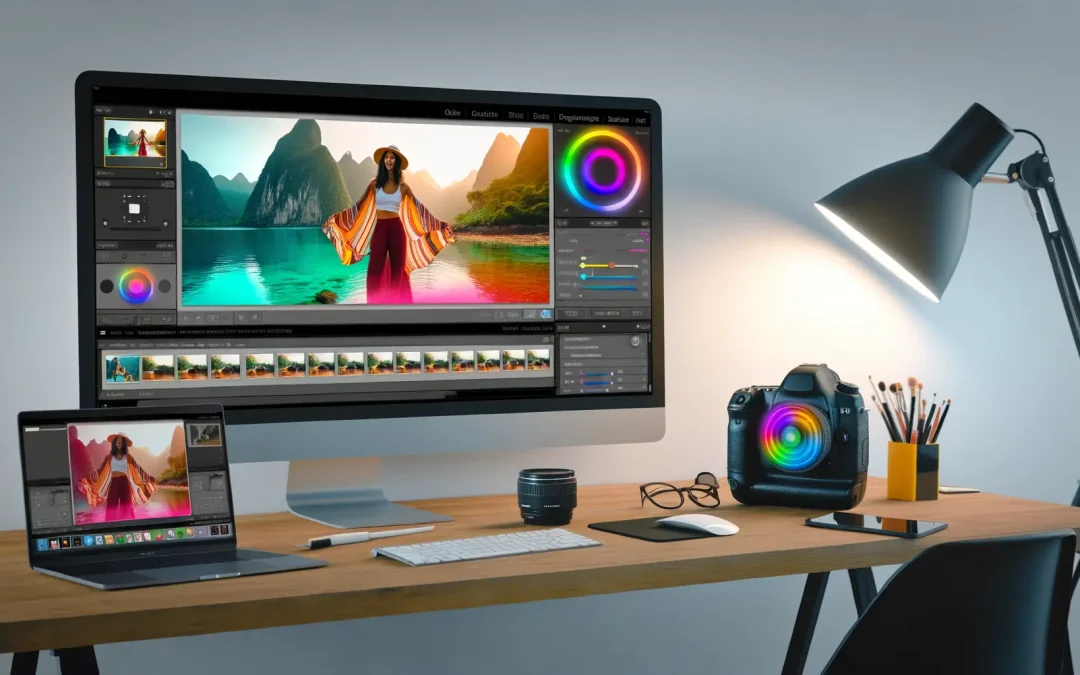Looking to enhance your photography skills? Editing photos in Lightroom is your first step toward creating stunning visuals. This guide breaks down essential techniques, empowering you to transform your images using the latest trends and equipment in the photography world.
Understanding Lightroom’s Interface
Lightroom’s interface is elegantly designed for photographers at all levels.
Let’s have a chat about understanding this interface. Once you launch Lightroom, you’re greeted with a workspace that’s both structured and surprisingly intuitive. To your left, you’ll find the Library Module. This is your gateway to organising photos. Think of it as your virtual photo album, where you can manage collections and find images within seconds. On the other side, to your right, the Develop Module is where the magic happens. This is your editing playground, loaded with tools to tweak and refine your shots. You might feel like an artist ready to paint, with all the brushes laid out before you.
In the middle, we have the Grid and Loupe views. Now, while the Grid lets you see your images in a handy overview, the Loupe is your zoomed-in focus—crucial when details matter. So, don’t ignore these, they could really change how you engage with your photos.
Navigating between these features isn’t hard either. Lightroom’s design flows logically, expecting your needs before you even think of them. It’s like the software has a mind reader built in. Perhaps no one will tell you, but keyboard shortcuts really are a game-changer. Invest some time to learn these and watch as your editing speeds up.
And let’s not forget the trends in photography editing. AI-driven preset filters are popping up everywhere. Using these can help ensure consistency in your work. But don’t just follow trends blindly. Maybe take inspiration from them and sprinkle your own flair.
Choosing the right tools doesn’t have to be a shot in the dark. For more insights on photography styles, check out this guide. It’s akin to choosing the right paints or brushes for your masterpiece.
Basic Editing Techniques for Beginners
Editing photos in Lightroom begins with mastering a few core techniques.
First, let’s talk about exposure. This isn’t just about light or darkness; it’s the backbone of every photo you edit. Slide your exposure bar gently. Notice how it affects the mood. Too much, and you’ve lost detail. Too little, and the image feels cramped. I like to start here because it instantly reshapes your shot, even if you’re unsure where to head next.
Now, contrast brings attention to your subject, separating lighter and darker areas. Experiment with it. It adds drama and depth, though too much can sometimes feel a bit overbearing. I remember a time when I fiddled too much with contrast and ended up with a photo that looked straight out of a comic book!
Then there’s saturation. A touch can liven things up. Colours pop, enhancing the story you want to tell. But, always approach this with caution. Overshooting on saturation leads to unrealistic skin tones or unnatural landscapes. Sometimes, backing off creates a more sophisticated look.
The easy way to practice these techniques is to choose a single photo and patiently adjust each setting. Compare versions, and slowly you’ll develop an instinct. Of course, there are some fantastic tutorials out there for those who like extra guidance, like this one on how to choose the right camera for your photography style.
Once you make friends with these basic tools, you unleash consistency. You’ll notice improvements in your edits, capturing a polished, professional feel. Give it some time. You might surprise yourself with what you achieve without realising you’ve even touched the sliders.
Advanced Tips to Elevate Photo Quality
Advanced editing in Lightroom is your ticket to elevating photo quality.
Now, let’s get one thing straight. We aren’t rehashing beginner territory here because you’ve already mastered the basics, haven’t you? It’s time to dive into more nuanced techniques that can turn your photos from good to truly captivating.
Let’s talk about presets. They can be a lifesaver, or so I’ve heard from countless photographers. A properly chosen preset acts like a shortcut, instantly applying a set of complex adjustments to your images. Now, don’t just rely on popular bundles, although some are great. Explore more custom presets as well, like those available on Lightroom’s marketplace, to find what genuinely resonates with your style.
Moving on to advanced colour grading. This is where the artistry really begins. It’s about more than just tweaking individual colours; it’s a subtle, intentional shift in your image’s mood and tone. Get comfortable with the HSL panel. Explore how minor adjustments can significantly change the feel of a photograph.
Don’t shy away from filters, either. Not the Instagram kind, but professional-grade ones. These can add depth and dimension without overdoing it—just the right balance to make images pop. And while we’re talking about trends, I reckon keeping an eye on them is advantageous. Navigating current trends can occasionally rejuvenate your creative perspective, steering your techniques in fresh directions.
Leverage the tools at your disposal, and if you’re curious about gear, maybe have a read on choosing the right camera for your style. Even your equipment can profoundly impact your editing approach.
Feeling overwhelmed? It’s normal. Consider reaching out to Alex Smale for personalised advice—sometimes, a more tailored nudge is all it takes to transform your workflow. After all, everyone’s journey with Lightroom is different, and a little expert guidance can make a world of difference.
Final words
Mastering photo editing in Lightroom opens a world of creativity and professional growth. By understanding its interface, practicing key techniques, and applying advanced tips, photographers can significantly enhance their images. Embrace the latest trends and equipment to stay ahead. For further guidance, reach out for personalized advice and start transforming your photography journey today.

